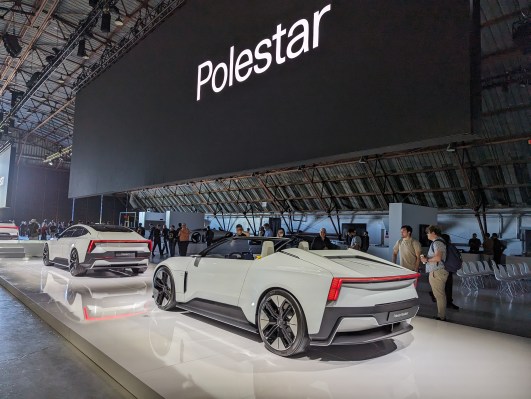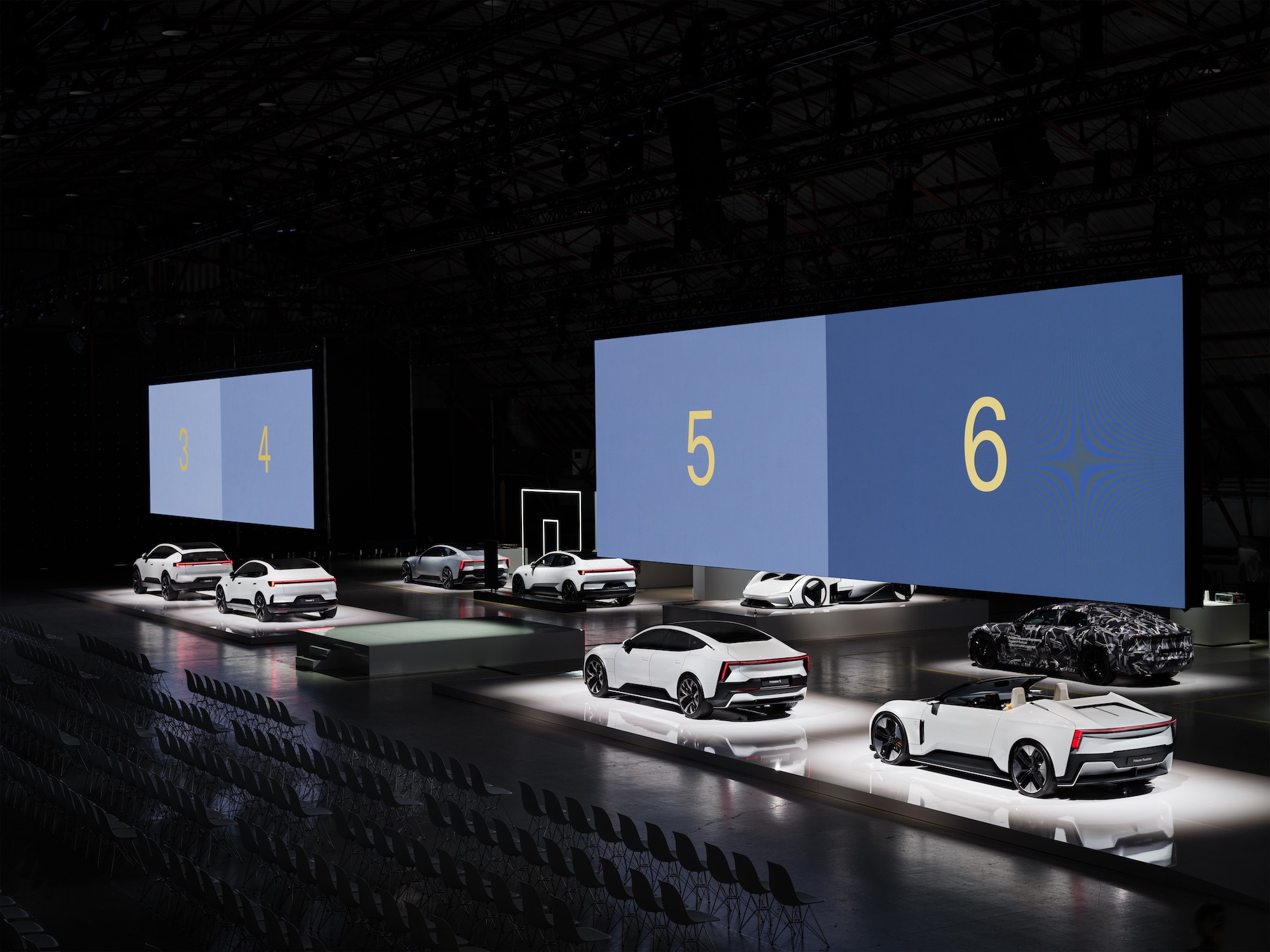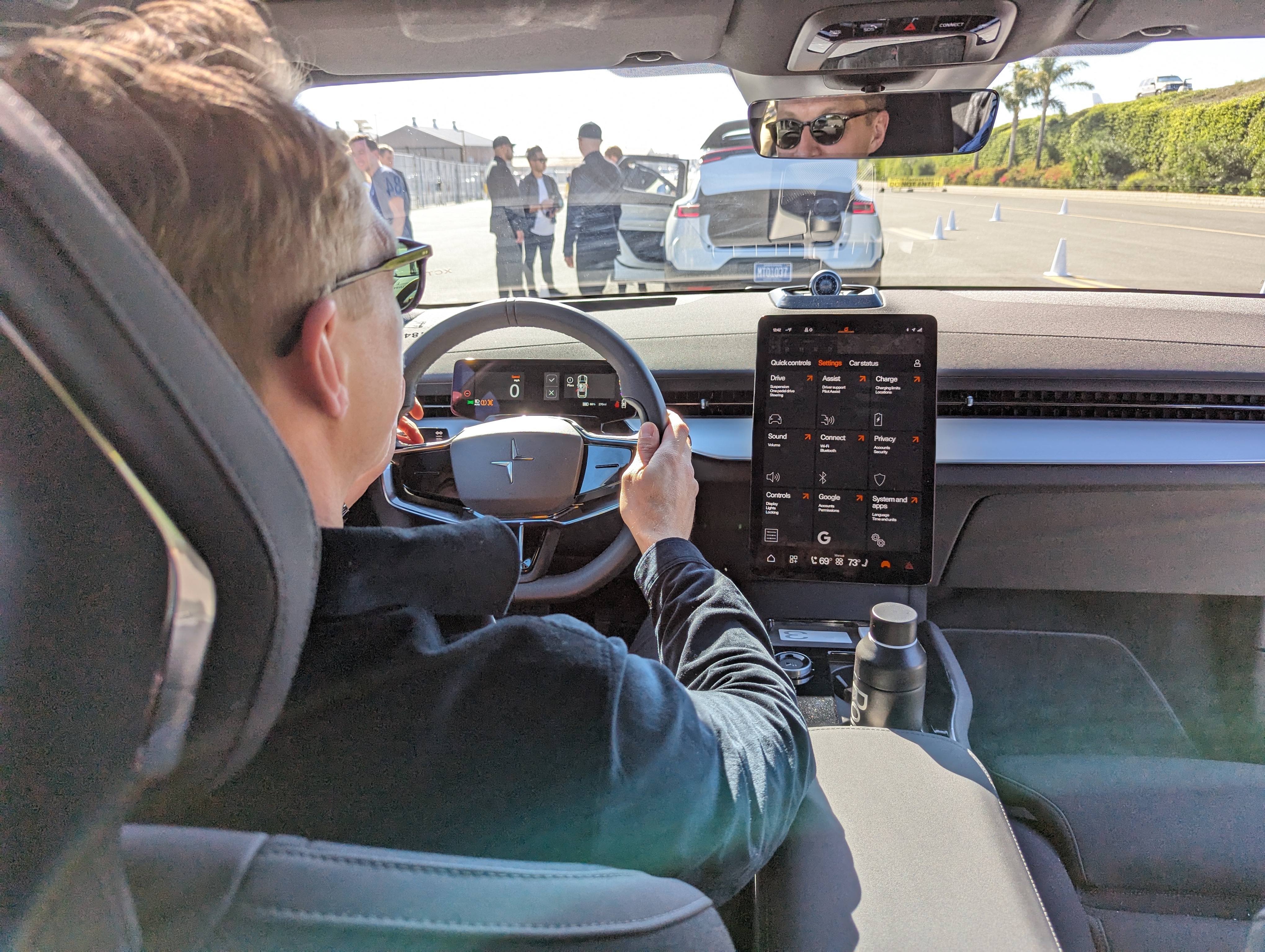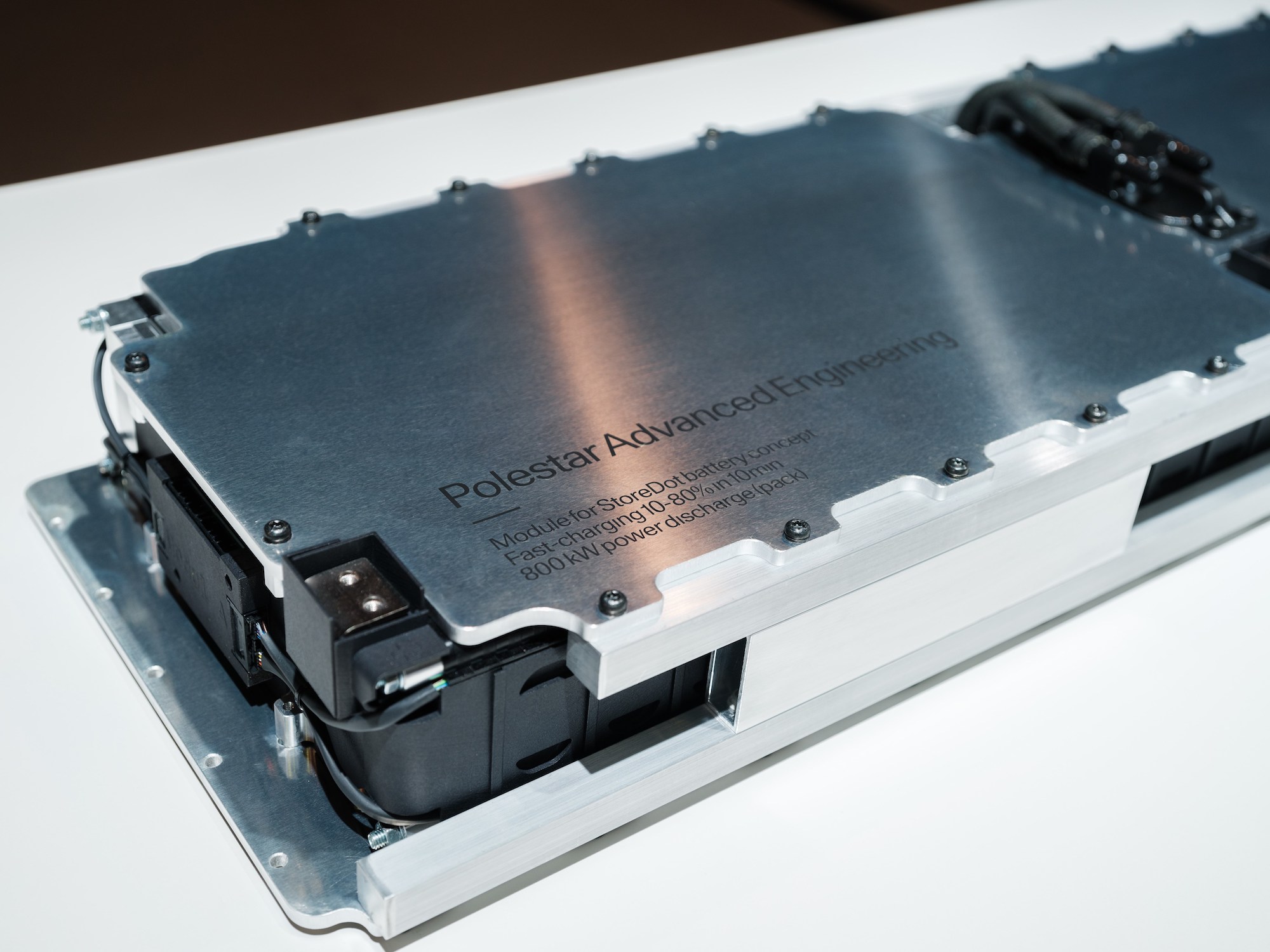Polestar showcased this week its vision for the future: new tech and next-generation vehicles that the Swedish EV company owned by China’s Geely Holdings hopes will spark sales and spur an era of growth.
The inaugural Polestar Day event in Los Angeles — designed to sell investors and journalists on its potential for a profitable future — stood in stark contrast to its present. Just a day prior, the company revised its outlook, cut delivery targets for 2023, announced a fresh investment from Volvo and Geely, and told the market that it’s still going to need another $1.3 billion in external funding in debt and equity until cash flows break even in 2025.
Walking that line between the company’s financial reality and its product aspirations put even more focus on the event itself.
“Polestar Day has of course, a big meaning for us to actually portray and highlight this innovation mélange that is coming together here,” Polestar CEO Thomas Ingenlath told TechCrunch in an interview during the event.
And a mélange it was: The company showed off its full future line-up, including the Polestar 3, 4, 5, Polestar Precept, the Polestar Electric Roadster Concept and the Polestar Synergy. It also made a handful of announcements that at least nominally pulled together its vision for the future and offered investors and journalists rides in the upcoming Polestar 3 and Polestar 4.
The focus on upcoming models, extremely fast charging, automated driving sensor integration, future vehicle-to-grid technology and announcements about manufacturing suggests Polestar is taking an all-of-the-above approach to growth even as it faces headwinds.
The headwinds are considerable. EV adoption has slowed, especially in the luxury market. The EV industry has been further hamstrung by high interest rates, tariff pressures to bring production to the U.S., economic uncertainty in China and two wars around the world.
Polestar, a small, luxury, performance EV automaker, is in a tighter position — even with large-scale investors like Volvo and Geely. The company has just one model, the Polestar 2, in the U.S. market.
With a recent downward revision to global sales for 2023, all eyes are on the Polestar 3 and Polestar 4.
Banking on Polestar 3 and Polestar 4
“When we talk about what is happening to this company in the next 18 months,” Ingenlath said, “these products are coming out in the market and at the same time, we’ve sat down and made sure that we are, in 2025, a profitable company that is cash flow break even.”
The Polestar 3 is due to begin U.S. deliveries in early 2024 and the Polestar 4 goes into production soon, with deliveries in 2025.
Ingenlath says that the company is counting on the Polestar 3 and Polestar 4 to help it reach its breakeven goals by 2025.
“Polestar 3 and 4 are key enablers; they are the core of the business,” he said, underlining the company’s focus on price over volume.
First Rides: Polestar 3 and Polestar 4
The company offered attendees the opportunity to ride along in pre-development versions of their forthcoming Polestar 3 and Polestar 4 in short, 10-minute trips around the Santa Monica Airport in stop-and-go traffic.
The Polestar 3 is the more “luxurious,” and larger of the two vehicles, with an SUV-like roofline, ample backseat space and a fully digital cockpit. It’s also the first vehicle that the company has built on a completely new platform. From the backseat the Polestar 3 is quiet, cavernous and comfortable with plenty of leg and headroom. It comes with air suspension that lends itself to enough roadfeel to feel connected, without the heaviness, making it nimble and lighter on its feet.
There’s a single vertical infotainment screen in the center of the dash, and a driver’s information screen attached to the steering wheel column. While you control most of the vehicle’s features (like one-pedal mode and different driving modes), through the main infotainment screen, controls for the headlights and windshield wipers are on the stalk within easy reach.
The Polestar 4 is the SUV-coupe of the lineup, with a swooping roofline and — believe it or not — no rear window. That untraditional omission allowed designers to give rear passengers more headroom and legroom, according to the company. The Polestar 4 has a slightly shorter wheelbase than the 3, but from a rear passenger’s perspective, it doesn’t feel claustrophobic — even without the rear window.
The Polestar 4 features the driver’s digital rearview mirror. The sunroof extends back just behind the crown of the rear passenger’s heads so it doesn’t feel like a coffin, even though there’s no glass behind the seats. Ambient lighting around the interior almost makes the lack of a rear window unnoticeable.
The Polestar 4 also gets a large central infotainment screen, but it is oriented horizontally, rather than vertically and the driver’s information screen is mounted to the dash, instead of the steering column. There is no HUD in the Polestar 4, and unlike the 3, it comes with steel spring suspension. That set up makes it feel harsher on potholed roads and translates undulations and heavy-feeling movement for passengers in the rear seats.
The technology and the ride-along experience wasn’t the surprising part. Instead, it was how excited customers who joined TechCrunch in the cars were for the future vehicles. One customer from Indiana told us that he had a Polestar 3 on order and during the ride along he was so thrilled by the infotainment screen features, he couldn’t keep his hands off them.
Future batteries, V2G and automated driving
Polestar also used its inaugural event to highlight tech partnerships with companies like Luminar, Mobileye and StoreDot, a battery company that Polestar invested in last year.
Most of these tech partnerships, such as its relationship with lidar company Luminar, aren’t new; the companies had announced an agreement to work together in February this year, and plans to incorporate lidar alongside the Mobileye Chauffeur technology were announced in August 2023.
The point, it seems, wasn’t to make new announcements, but instead show which capabilities these next-gen vehicles could have.
For instance, the Polestar 4 will have lidar, which will support an advanced driver assistance system that will provide eyes-off automated driving on highways. That system, however, is not fully baked.
During the presentation, Mobileye CEO Amnon Shashua, who was not in attendance but had pre-recorded his statements, showed off video of a Polestar 4 using Mobileye technology to navigate a roundabout. While the vehicle was able to successfully enter traffic, merge and exit without input by the driver, it was not the smoothest execution. The video showed the prototype vehicle stopping and starting as it entered the roundabout traffic, much like an unsure driver would. During his recorded remarks, Shashua said that the video was recorded just last week.
Perhaps one of the more intriguing companies highlighted at the event was StoreDot, an Israel-based battery company that makes pouch cell batteries with what it calls extremely fast-charging or XFC capabilities.
Polestar first invested in StoreDot in May 2022 and now it’s aiming to incorporate a so-called “0-100 in 5 minutes” silicon anode battery technology into future EVs.
StoreDot CEO and co-founder, Doron Myersdorf, was on hand at the Thursday event, demonstrating a small-scale model of the XFC battery technology, charging a few cells to 80% in just under eight minutes.
StoreDot has developed the battery cells, while Polestar, a “key investor and collaborator,” has worked alongside the company to develop the battery chassis and liquid cooling system that keeps the fast-charging cells below 40 degrees C — a critical point for efficient charging. Myersdorf said that the technology had been tested through 1,000 fast-charging cycles and said that there was no more battery degradation than you’d find when charging slowly.
“Slow charge and fast charge are the same for this technology,” Myersdorf said, “So you could basically get a warranty of half a million miles” on the battery. He also noted that the battery doesn’t just die after 1,000 charges but will only charge to 80%. Polestar and StoreDot say they will demonstrate the jointly developed battery pack at full scale in a Polestar 5 prototype sometime in 2024.
Polestar also announced vehicle-to-grid or V2G plans in Sweden and California. The company has agreed to be a part of a coalition of energy distributors and suppliers, home charging suppliers and university researchers for a pilot project leveraging V2G technology and a fleet of Polestar 3s in and around Gothenberg, Sweden. In California, Polestar announced that it’s going to participate in a pre-study to create a roadmap for V2G technology in the state. The project in Sweden will run for two years, starting in 2024, and the pre-study in California will commence in December and run for a year.
It’s still very early for this kind of technology, and there are plenty of hurdles to overcome — everything from legislative struggles to infrastructure. Yet if the V2G tech works as Polestar hopes, it would make Polestar’s new Virtual Power Plant or VPP usable. Polestar said that the cloud-based VPP system would allow Polestar3 owners to put energy back into the grid when their vehicle is parked — whether at home or out in public.
The path forward
As the EV industry continues to constrict, smaller automakers like Polestar will have to move quickly to stay afloat.
Ingenlath says he’s upbeat about Polestar’s future.
“We should not be super shocked about the EV market,” Ingenlath said referring to the softening of EV demand, “I mean, the crucial thing is how much are you prepared as a company to go through such a valley?” he continued. “We definitely will survive.”



